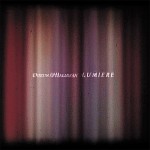DUSTIN O’HALLORAN: Lumiere (130701/Fat-Cat Records)
By themilkman
Posted on Feb 16th 2011 01:03 am
Filed in Albums | Tags: Dustin O'Halloran, Fat-Cat Records
Comments (0)
DUSTIN O’HALLORAN
Lumiere
CD1314/LP1314
130701/Fat-Cat Records 2011
09 Tracks. 43mins18secs
![]() Amazon UK: CD | LP | DLD US: CD | DLD Boomkat: CD | LP
Amazon UK: CD | LP | DLD US: CD | DLD Boomkat: CD | LP
A grainy, flickery and blurred vision of what could be a heavy curtain of the type you use to find in cinemas before the days of multiplex complexes, upon which is projected a name and a word, LUMIERE, appearing fuzzy and distorted; the cover of Dustin O’Halloran’s debut for Fat-Cat’s modern classical sister imprint 130701 spells things out loud and clear even before a single note has played: this is cinematic music. But, if both the title, French for light, but, more fittingly, also the name of the two pioneering French filmmaker brothers who premiered their first film in Paris in 1895, and the visual shown on the cover, could lead to think that this album pays tribute to the art of cinematography, it is not quite the case.
O’Halloran is a Californian pianist and composer who currently resides in Berlin. Lumiere follows two previous solo piano records, released on Splinter Records and Bella Union respectively, and a mini-album published on Sonic Pieces last year. With this album, O’Halloran expands on his original stripped down compositions by adding discreet electronic brushes, strings sections, recorded with the New York formation ACME Ensemble, who have in the past been noticed alongside the likes of Max Richter, Nico Muhly, Hauschka, Matmos or Grizzly Bear, with additional contributions from Peter Broderick on violin and Stars Of The Lid’s Adam Wiltzie on guitar.
This vastly widened scope suits O’Halloran’s wonderful melodies and pace extremely well. Right from album opener A Great Divide, there is no denying the intensity with which the swirls of orchestral phrases develop and highlight every nuance in the melody. While his pieces are predominantly melancholic, O’Halloran works melodies into extremely tight and finely detailed constructions and plays with an ever changing array of lights and shades to give each of his composition a totally unique identity. The autumnal tone of Quartet No. 2 is set almost entirely by the string formation, its elegant theme ebbing and flowing through the whole piece. Elsewhere thought, it is often the piano which is at the core of a piece, either, as is the case on Opus 44 and Opus 55, alone, or placed against stunning orchestral swathes. On We Move Lightly, Opus 43 or the achingly beautiful Fragile No. 4 and Snow And Light, the strings appear to wrap around O’Halloran’s piano lines, reacting to the most delicate nuances in the flow, as to highlight them for fear that they should disappear without trace, while on A Great Divide or Quintet No. 1, the dynamic is quite different as Peter Broderick leads the string formation into taking control, a move that O’Halloran wholeheartedly supports by adopting a low profile, especially on the former.
Lumiere represents an important steps forward for Dustin O’Halloran. While he has been gaining considerable recognition in recent years, this album places him firmly on a par with the likes of Max Richter, Greg Haines or Jóhann Jóhannsson, and shows him as an incredibly gifted composer whose flair for exquisite melodies is quite simply second to none.
4.7/5
![]() Dustin O’Halloran | Dustin O’Halloran (MySpace) | Fat-Cat Records
Dustin O’Halloran | Dustin O’Halloran (MySpace) | Fat-Cat Records
![]() Amazon UK: CD | LP | DLD US: CD | DLD Boomkat: CD | LP
Amazon UK: CD | LP | DLD US: CD | DLD Boomkat: CD | LP
Filed in Albums | Tags: Dustin O'Halloran, Fat-Cat Records
Comments (0)



